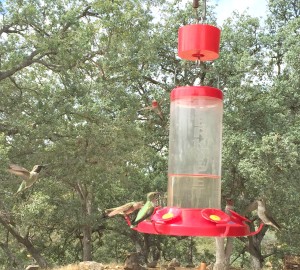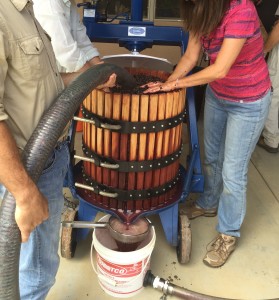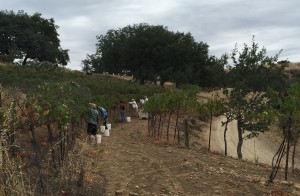 An overcast sky keeps the heat down. A few drops even fall from the sky but the effort quickly fizzles. Each worker’s face and hands disappear into the green leaves looking for good clusters of grapes. The clusters are few, the grapes are small. The late rains have knocked down production everywhere. Last year it was the May heat that caused so many fires that slowed production. Many of the vines are barren, or the grapes are too shrivelled to use. I find a couple of spots with good grapes. I load up my bucket, snipping away at the healthy clusters.
An overcast sky keeps the heat down. A few drops even fall from the sky but the effort quickly fizzles. Each worker’s face and hands disappear into the green leaves looking for good clusters of grapes. The clusters are few, the grapes are small. The late rains have knocked down production everywhere. Last year it was the May heat that caused so many fires that slowed production. Many of the vines are barren, or the grapes are too shrivelled to use. I find a couple of spots with good grapes. I load up my bucket, snipping away at the healthy clusters.
 Ironically, the low hanging fruit is harder to get at than the high hanging fruit. I have to squat down, working my old knees, to get the clusters near the ground. When I top off the bucket, I dump it into a bin. As the bin fills, the forklift comes by and carries it back to the house for processing. The migrant crew quickly works through the two vineyards, one Sauvignon Cabernet, one Sauvignon Franc, working from row to row. Our farmers have thoughtfully provided music and the workers make decent company as we work our way through the vineyards.
Ironically, the low hanging fruit is harder to get at than the high hanging fruit. I have to squat down, working my old knees, to get the clusters near the ground. When I top off the bucket, I dump it into a bin. As the bin fills, the forklift comes by and carries it back to the house for processing. The migrant crew quickly works through the two vineyards, one Sauvignon Cabernet, one Sauvignon Franc, working from row to row. Our farmers have thoughtfully provided music and the workers make decent company as we work our way through the vineyards.
As Steinback suggested in the Grapes of Wrath, the migrant workers have united. Except most of the migrant workers are actually neighbors that also own their own vineyards. They help each other out with labor, parts, and expertise. I think Steinback wanted to organize labor against the landowners. But cooperation amongst small time landowners seems like an even better social and work model.
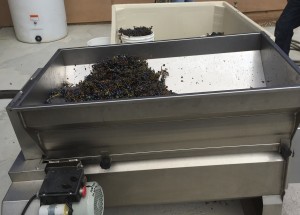 Most of the landowners are on their second or third careers as vintners. So I am one of the few real migrant workers in the small group of laborers. I collect nearly three full buckets worth of grapes. By my estimates, maybe fifty or so pounds. A hundred pounds of grapes makes about 6 gallons. Six gallons is about thirty bottles worth of labor. Only two bins of grapes are collected this year. Two years ago we collected some eight or nine bins. Each bin is a square, the size is about the length of a bath tub and the depth slightly deeper.
Most of the landowners are on their second or third careers as vintners. So I am one of the few real migrant workers in the small group of laborers. I collect nearly three full buckets worth of grapes. By my estimates, maybe fifty or so pounds. A hundred pounds of grapes makes about 6 gallons. Six gallons is about thirty bottles worth of labor. Only two bins of grapes are collected this year. Two years ago we collected some eight or nine bins. Each bin is a square, the size is about the length of a bath tub and the depth slightly deeper.
Back at the house, the grapes are moved from the bin to a destemmer. The destemmed grapes are pumped from the destemmer into a wine press. From the press, the juice is pumped in a plastic storage container. The must, the juice before it ferments, will be shocked with SO2 to kill off any wild yeast. Wild yeast has unpredictable taste, so cultivated yeast of known quality is preferred. The Franc and the Cab are combined to make a Rose because there are not enough grapes to make separate vintages. The by product of all our labors, is a grape skin cake, a cylinder of grape skins about two feet high.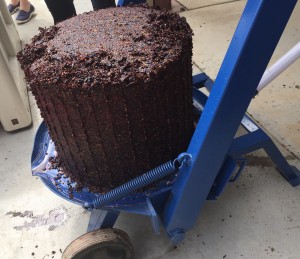
For my effort, I am treated to a delicious lunch, a few glasses of wine, and an afternoon of hanging out by the oaks on the mesa with our less than ruthless landowners and their friends. They send me off with a couple of more bottles for the effort. Migrant workers never had it so good.
